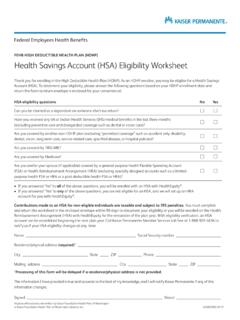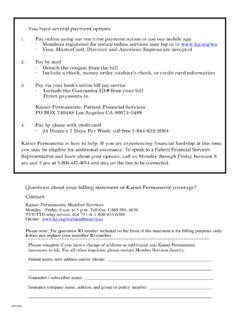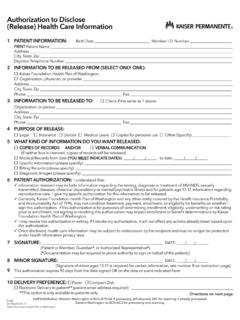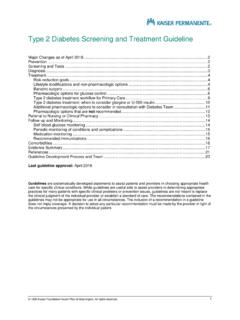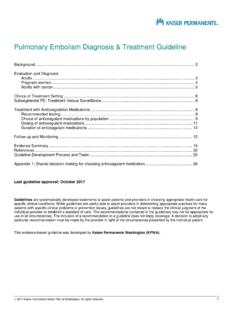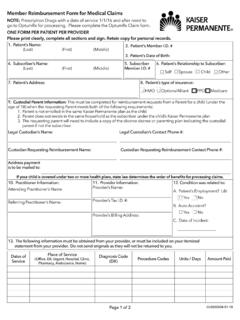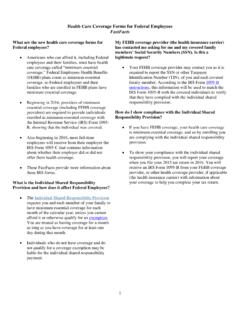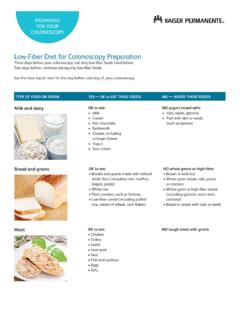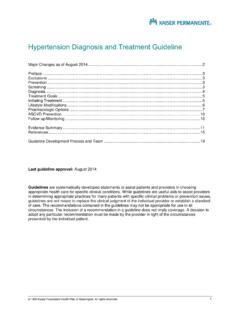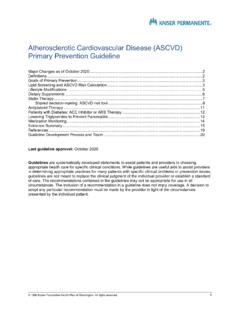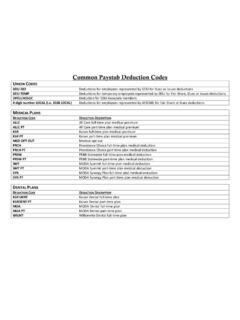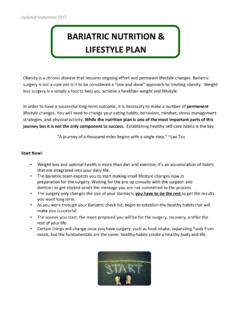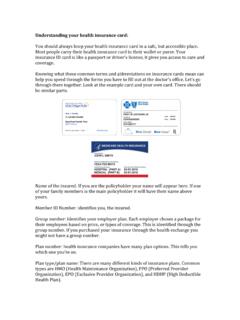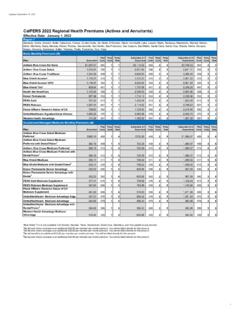Transcription of Asthma Diagnosis and Treatment Guideline - Kaiser …
1 1999 Kaiser Foundation Health Plan of Washington. All rights Asthma Diagnosis and Treatment Guideline Interim Update March 2 Definition .. 2 2 Classify Current Severity .. 3 Table 1. Classifying Asthma severity in patients not currently taking medications .. 3 Assess Control .. 4 Tables 2 4. Assessing Asthma control in patients currently taking medications (by age group) .. 4 Treatment Goals .. 7 Non-Pharmacologic Interventions: education, self-management, lifestyle, comorbidities .. 7 Pharmacologic Options .. 8 Stepwise approach to Treatment .. 8 Table 5. Recommended step for initiating Treatment based on Asthma severity.
2 8 Table 6. Stepwise approach to long-term Asthma control .. 9 Inhaled corticosteroid (ICS) conversion .. 10 Table 7. Conversion from beclomethasone (QVAR) to ciclesonide (Alvesco) .. 10 Medication dosing .. 11 Table 8. Asthma medications: low and medium dosing .. 11 Follow-up/Monitoring .. 13 Table 9. Recommended periodic monitoring of conditions and complications .. 13 Recommended Immunizations for Patients with Asthma .. 14 Referral .. 14 Evidence Summary .. 15 References .. 18 Guideline Development Process and Team .. 19 Appendix 1: Asthma Control Test for Patients Aged 4 11 Years .. 20 Appendix 2: Asthma Control Test for Patients Aged 12 Years and Older.
3 21 Last Guideline approval: July 2015 Interim update: March 2019 Guidelines are systematically developed statements to assist patients and providers in choosing appropriate health care for specific clinical conditions. While guidelines are useful aids to assist providers in determining appropriate practices for many patients with specific clinical problems or prevention issues, guidelines are not meant to replace the clinical judgment of the individual provider or establish a standard of care. The recommendations contained in the guidelines may not be appropriate for use in all circumstances. The inclusion of a recommendation in a Guideline does not imply coverage.
4 A decision to adopt any particular recommendation must be made by the provider in light of the circumstances presented by the individual patient. 2 Interim Update March 2019 For patients aged 12 years and older, ciclesonide (Alvesco) has replaced beclomethasone (QVAR) as the preferred inhaled corticosteroid (ICS) at KP Washington. Recent evidence has shown Alvesco to be safe and efficacious in patients aged 5 11 years, and for these patients it can be used as a first-line agent in situations where fluticasone (Flovent) is cost-prohibitive. The KPWA Asthma Guideline has received an interim update to reflect these changes, with Alvesco replacing QVAR in the Pharmacologic Options section (see pp.)
5 8 12). A dosing conversion table has also been added. Note: ICS recommendations for patients under 5 years old are unchanged. Definition Asthma is a chronic inflammatory disorder of the airways. It is defined by the history of respiratory symptoms such as wheezing, shortness of breath, chest tightness and cough that vary over time and in intensity, together with variable expiratory airflow limitation (GINA 2014). Diagnosis Asthma is a Diagnosis of exclusion. It is important to consider the pattern of symptoms and triggers and to rule out conditions that cause wheezing, coughing, and dyspnea before making the Diagnosis . The evidence for the Diagnosis of Asthma should be documented before starting controller Treatment , as it is often more difficult to confirm a Diagnosis afterwards.
6 To establish a Diagnosis of Asthma : 1. Use history and physical to determine whether symptoms of recurrent episodes of airflow obstruction or airway hyper-responsiveness are present. Symptoms include: Wheezing (polyphonic, musical or whistling sounds, predominantly expiratory) Cough Chest tightness Dyspnea Worsening of symptoms at night or in the presence of environmental stimuli 2. Use spirometry in patients 5 years and older to determine whether airflow obstruction is at least partially reversible after use of a bronchodilator. In patients of all ages, reversibility is indicated by an increase of at least 12% in FEV1 from baseline.
7 In adults, an increase in FEV1 of greater than 200 mL from baseline also constitutes reversibility. Note that having normal lung function does not exclude the Diagnosis of Asthma , especially in children. A note about spirometry Spirometry provides an objective measurement of Asthma severity and response to therapy and can be useful in assessing patients who may under-report or over-report their symptoms. Spirometry should be considered when: Considering an initial Diagnosis of Asthma (or as part of differential Diagnosis ) Assessing response to Treatment after a change in medication Assessing Asthma control in patients with persistent Asthma 3.
8 Exclude alternative diagnoses such as pulmonary diseases ( , COPD, pulmonary fibrosis, bronchiectasis), upper airway conditions ( , chronic allergic rhinitis and sinusitis, vocal cord dysfunction, obstructive sleep apnea), congestive heart failure, and other causes ( , foreign body in trachea or bronchus, GERD, enlarged lymph nodes or tumors, cystic fibrosis, drug-related cough). 3 Classify Current Severity Asthma severity (see Table 1) is used to guide Treatment decisions in patients with either a new or a past Diagnosis of Asthma who are not currently on medication. (For patients currently taking medications, see Assess Control, pp.)
9 4 6.) Severity is easiest to assess at the initial Diagnosis , before patients are taking long-term control medications, but it can also be measured once Asthma control is achieved by determining the amount of medication needed for control. Severity is classified as intermittent or persistent (mild, moderate or severe). Note: Because children under age 5 are more likely to have wheezing episodes than older children or adults, Asthma is more difficult to diagnose in this age group. At times reactive airway disease (RAD) in young children will remit around 5 years of age. However, some of these patients will continue to have symptoms.
10 Children under 5 years of age who have RAD and also certain risk factors (sensitization to foods and/or inhaled allergens, atopic dermatitis, wheezing apart from colds, and parental history of Asthma ) are more likely to have continued symptoms after 5 years of age and are more likely to respond to inhaled corticosteroids (ICS). Classify Asthma severity: patients of all ages Table 1. Classifying Asthma severity in patients NOT currently taking medications (includes recently diagnosed patients and those with a past Diagnosis not currently on medication) The result is based on the most severe category of impairment or risk. Impairment (Over last 2 4 weeks) Intermittent Asthma Persistent Asthma Mild Moderate Severe Symptoms 2 days/week 3 days/week but not daily Daily Throughout day Nighttime awakenings Age 5 years 2 nights/month 3 4 nights/month > 1 night/week but not nightly Often 7 nights/week Age < 5 years None 1 2 nights/month 3 4 nights/month > 1 night/week Short-acting beta2-agonist use (for rescue, not exercise prophylaxis)
